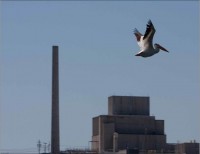
The U.S. Department of Energy (Energy) released its highly-anticipated plan on one of the greatest cleanup challenges at the Hanford Nuclear Reservation: addressing pollution from 177 buried tanks containing 56 million gallons of extremely radioactive, high level nuclear waste. Many tanks are already leaking. Despite overwhelming opposition from public health and environmental groups, Energy’s plan sets the stage for importing more radioactive waste to Hanford and leaving large amounts of waste in the ground. Energy’s “Tank Closure Waste Management Environmental Impact Statement” (EIS), a 6,000 page document, comes less than two months after the agency’s announcement that a double-shelled tank is leaking nuclear waste at Hanford.
“Energy’s own analysis clearly demonstrates that importing new waste to Hanford will only compound the existing problems, not accelerate the cleanup. The government’s latest plan fails to take the bold steps needed to protect people who rely on the Columbia for their livelihoods and endangered salmon that depend on the Columbia for their survival,” explained Columbia Riverkeeper’s Conservation Director, Dan Serres, who also serves on the Hanford Advisory Board.
Energy’s latest report is one of the most anticipated cleanup decisions in the history of Hanford. A legacy of World War II and the Cold War, Hanford is the most contaminated sites in the western hemisphere. Energy’s EIS looked at various alternatives for dealing with leaky nuclear waste tanks, and sets the stage for the agency to adopt a final decision within the next month.
Over 56 million gallons of liquid high-level nuclear waste is currently stored in underground tanks, 62 of which leaked in the past. Thirty-five million gallons of this waste is in deteriorating single-shelled tanks, with over one million gallons having already leaked or overflowed into the soil.
Major flaws in Energy’s decision include:
- Energy failed to decide how to treat roughly half of the existing low-activity waste. Energy’s highly-controversial waste treatment plant, which will turn radioactive waste into glass, only has enough capacity to treat half of the existing low-activity waste. The $12 billion waste treatment plant is years behind schedule and over budget.
- Hanford’s aging single-shelled underground tanks have leaked over a million gallons of radioactive and toxic pollution into the soil and groundwater. Energy will empty out the tanks, but then plans to bury them and largely ignore the contaminated soil underneath, ensuring continued groundwater contamination.
- As soon as the waste treatment plant is operational, Energy plans to import off-site waste and bury it at Hanford, even though importing waste would significantly increase groundwater pollution and threaten the Columbia River.
“There is no doubt that radioactive and toxic pollution from Hanford is already entering the Columbia River. If we don’t thoroughly clean up the nuclear waste under the tank farms it will further contaminate the river downstream,” stated Serres.
According to the report, Energy projects that without aggressive cleanup, contamination will continue to reach the Columbia River and the danger will increase for some pollutants. For example, carbon tetrachloride concentrations reaching the Columbia River will climb to 50 times the pollution standard in 125 years. For uranium-238, iodine-129 and other pollution Energy’s projects potential contamination reaching the Columbia River thousands of years into the future.

This product was funded through a grant from the Washington Department of Ecology. While these materials were reviewed for grant consistency, this does not necessarily constitute endorsement by the Department.
Washington officials fear further cleanup delays at Hanford nuclear reservation


